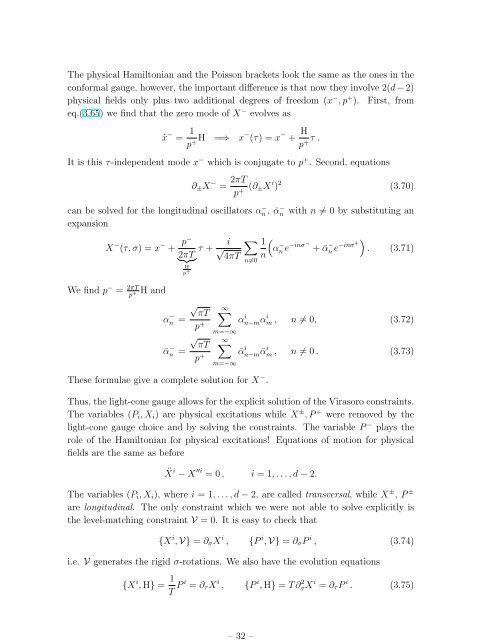Lectures on String Theory
Lectures on String Theory
Lectures on String Theory
You also want an ePaper? Increase the reach of your titles
YUMPU automatically turns print PDFs into web optimized ePapers that Google loves.
– 32 –<br />
The physical Hamilt<strong>on</strong>ian and the Poiss<strong>on</strong> brackets look the same as the <strong>on</strong>es in the<br />
c<strong>on</strong>formal gauge, however, the important difference is that now they involve 2(d − 2)<br />
physical fields <strong>on</strong>ly plus two additi<strong>on</strong>al degrees of freedom (x − , p + ). First, from<br />
eq.(3.65) we find that the zero mode of X − evolves as<br />
ẋ − = 1<br />
p + H =⇒ x− (τ) = x − + H p + τ .<br />
It is this τ-independent mode x − which is c<strong>on</strong>jugate to p + . Sec<strong>on</strong>d, equati<strong>on</strong>s<br />
∂ ± X − = 2πT<br />
p + (∂ ±X i ) 2 (3.70)<br />
can be solved for the l<strong>on</strong>gitudinal oscillators αn − , ᾱn<br />
− with n ≠ 0 by substituting an<br />
expansi<strong>on</strong><br />
X − (τ, σ) = x − + p−<br />
}{{} 2πT<br />
τ + i<br />
p + H<br />
We find p − = 2πT<br />
p + H and<br />
√<br />
4πT<br />
∑<br />
n≠0<br />
1<br />
(<br />
αn − e −inσ− + ᾱn − e −inσ+) . (3.71)<br />
n<br />
α − n =<br />
ᾱ − n =<br />
√<br />
πT<br />
p +<br />
√<br />
πT<br />
p +<br />
∞<br />
∑<br />
m=−∞<br />
∑ ∞<br />
m=−∞<br />
α i n−mα i m , n ≠ 0, (3.72)<br />
ᾱ i n−mᾱ i m , n ≠ 0 . (3.73)<br />
These formulae give a complete soluti<strong>on</strong> for X − .<br />
Thus, the light-c<strong>on</strong>e gauge allows for the explicit soluti<strong>on</strong> of the Virasoro c<strong>on</strong>straints.<br />
The variables (P i , X i ) are physical excitati<strong>on</strong>s while X ± , P + were removed by the<br />
light-c<strong>on</strong>e gauge choice and by solving the c<strong>on</strong>straints. The variable P − plays the<br />
role of the Hamilt<strong>on</strong>ian for physical excitati<strong>on</strong>s! Equati<strong>on</strong>s of moti<strong>on</strong> for physical<br />
fields are the same as before<br />
Ẍ i − X ′′i = 0 , i = 1, . . . , d − 2.<br />
The variables (P i , X i ), where i = 1, . . . , d − 2, are called transversal, while X ± , P ±<br />
are l<strong>on</strong>gitudinal. The <strong>on</strong>ly c<strong>on</strong>straint which we were not able to solve explicitly is<br />
the level-matching c<strong>on</strong>straint V = 0. It is easy to check that<br />
{X i , V} = ∂ σ X i , {P i , V} = ∂ σ P i , (3.74)<br />
i.e. V generates the rigid σ-rotati<strong>on</strong>s. We also have the evoluti<strong>on</strong> equati<strong>on</strong>s<br />
{X i , H} = 1 T P i = ∂ τ X i , {P i , H} = T ∂ 2 σX i = ∂ τ P i . (3.75)

















